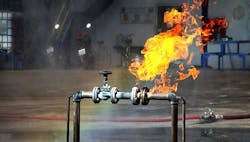In February 1999, a boiler blew up at a car factory. The boiler was shut down for cleaning and then purged with nitrogen. However, because of faulty controls and poor isolation, gas flowed to the burner from a gas line that was left open. After 90 seconds, the boiler exploded, setting off a coal dust explosion that killed six workers. This accident was one of the most expensive in history. (For more details, see Trevor Kletz’s “Still Going Wrong! Case Histories of Process Plant Disasters and How They Could Have Been Avoided,” 1st ed., p. 105.) The U.S. Occupational Safety and Health Administration keeps a record of steam boiler accidents, which happen more often than you might think.
Yes, I know your insurance company requires annual inspection of boilers. How much can an inspector look at, though? Does the person check your procedures or determine if safety equipment works or has been set up correctly? Probably not.
Now, consider your other utility systems: compressed air, nitrogen, water supply, refrigeration, cooling towers, natural gas and electricity. How many times have you considered safety, let alone reliability, of these vital services? What would happen if you lost compressed air? What about water or fuel gas? Too many sites have discovered the risks the hard way!
In December 2015, a loss of fuel gas to a boiler made the flares fail at a California refinery, leading to a reportable environmental event. (A few other times, the loss of boilers resulted in a shutdown of the refinery.)
In another incident, a paper mill closed its water line for repairs, but someone forgot to check with the powerhouse. Deprived of cooling water, oil in an air compressor overheated and exploded, killing one worker and injuring four others. A review later showed the temperature controls weren’t functioning but I’m sure there’s more to it. Given the poor maintenance of piping and instrumentation diagrams (P&IDs) and other drawings in plants, especially those for utility systems, I wonder if anyone knew how to properly isolate piping for maintenance. By the way, while many think that isometrics are appropriate for utilities, I’ve observed that P&IDs will do if they include sufficient mechanical details and orient the pipe network so it’s spatially correct.
[pullquote]
Roy Sanders cites an exploding compressor jacket caused by loss of cooling water on p. 148 of “Chemical Process Safety,” 3rd ed. At one plant I worked at, the motors for two water-cooled compressors burned up in the summer two years in a row. Kletz, on p. 8 of “Still Going Wrong!” blames badly marked pipe for an accidental break in a 100-psig air line; the pipe fitter was lucky that time. Poor documentation often underlies an incident. I wonder how many accidents plants could avoid if better documentation improved inspection and allowed better leak detection.
In February 2009, a gas line leaked in the powerhouse of a Pennsylvania steel mill. The line exploded, killing one laborer.
Not all powerhouse accidents involve gas, steam and air. In July 2018, two workers were burned from handling lime in a Kansas City water plant. In August 1976 and again in January 2003, explosions occurred in handling ion exchangers as part of uranium separation. This type of accident involving ion exchangers that use nitric acid or other corrosives in the backwash was so common years ago that equipment manufacturers often warned about the risks.
At another plant I worked at, a welder was slightly injured when his torch lit off a hydrogen cloud in the chiller room. Hydrogen results from acid leaking into a closed chilled water system. I actually was in the process of updating the P&IDs when the incident took place.
Recently, I recorded another near-miss because fouled cooling water threatened to trip our ammonia refrigeration relief valves. Fouled exchangers are a common issue at plants. Funny how the little things get overlooked.
Completing and maintaining P&IDs, isometrics and equipment files of utilities will help you identify additional elements to monitor in your plant: e.g., pressure vessels, thermal expansion, and material incompatibilities. After creating a P&ID for the compressed air system at one plant, I found several operating and design issues that badly needed attention. I wonder what I would have discovered if I looked at the fuel gas system?
DIRK WILLARD is a Chemical Processing Contributing Editor. You can email him at [email protected]
About the Author

Dirk Willard
Contributing Editor
DIRK WILLARD is a former ASBPE award-winning columnist for Chemical Processing's Field Notes column. During his 10+ years as a contributing editor for CP, he wrote hundreds of valuable and insightful pieces on design and operational issues. He retired in 2023.
